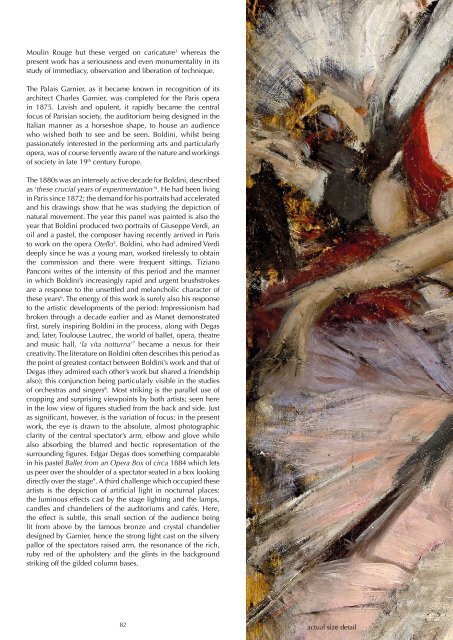Create successful ePaper yourself
Turn your PDF publications into a flip-book with our unique Google optimized e-Paper software.
Moulin Rouge but these verged on caricature 3 whereas the<br />
present work has a seriousness and even monumentality in its<br />
study of immediacy, observation and liberation of technique.<br />
The Palais Garnier, as it became known in recognition of its<br />
architect Charles Garnier, was completed for the Paris opera<br />
in 1875. Lavish and opulent, it rapidly became the central<br />
focus of Parisian society, the auditorium being designed in the<br />
Italian manner as a horseshoe shape, to house an audience<br />
who wished both to see and be seen. Boldini, whilst being<br />
passionately interested in the performing arts and particularly<br />
opera, was of course fervently aware of the nature and workings<br />
of society in late 19 th century Europe.<br />
The 1880s was an intensely active decade for Boldini, described<br />
as ‘these crucial years of experimentation’ 4 . He had been living<br />
in Paris since 1872; the demand for his portraits had accelerated<br />
and his drawings show that he was studying the depiction of<br />
natural movement. The year this panel was painted is also the<br />
year that Boldini produced two portraits of Giuseppe Verdi, an<br />
oil and a pastel, the composer having recently arrived in Paris<br />
to work on the opera Otello 5 . Boldini, who had admired Verdi<br />
deeply since he was a young man, worked tirelessly to obtain<br />
the commission and there were frequent sittings. Tiziano<br />
Panconi writes of the intensity of this period and the manner<br />
in which Boldini’s increasingly rapid and urgent brushstrokes<br />
are a response to the unsettled and melancholic character of<br />
these years 6 . The energy of this work is surely also his response<br />
to the artistic developments of the period: Impressionism had<br />
broken through a decade earlier and as Manet demonstrated<br />
first, surely inspiring Boldini in the process, along with Degas<br />
and, later, Toulouse Lautrec, the world of ballet, opera, theatre<br />
and music hall, ‘la vita notturna’ 7 became a nexus for their<br />
creativity. The literature on Boldini often describes this period as<br />
the point of greatest contact between Boldini’s work and that of<br />
Degas (they admired each other’s work but shared a friendship<br />
also); this conjunction being particularly visible in the studies<br />
of orchestras and singers 8 . Most striking is the parallel use of<br />
cropping and surprising viewpoints by both artists; seen here<br />
in the low view of figures studied from the back and side. Just<br />
as significant, however, is the variation of focus: in the present<br />
work, the eye is drawn to the absolute, almost photographic<br />
clarity of the central spectator’s arm, elbow and glove while<br />
also absorbing the blurred and hectic representation of the<br />
surrounding figures. Edgar Degas does something comparable<br />
in his pastel Ballet from an Opera Box of circa 1884 which lets<br />
us peer over the shoulder of a spectator seated in a box looking<br />
directly over the stage 9 . A third challenge which occupied these<br />
artists is the depiction of artificial light in nocturnal places:<br />
the luminous effects cast by the stage lighting and the lamps,<br />
candles and chandeliers of the auditoriums and cafés. Here,<br />
the effect is subtle, this small section of the audience being<br />
lit from above by the famous bronze and crystal chandelier<br />
designed by Garnier, hence the strong light cast on the silvery<br />
pallor of the spectators raised arm, the resonance of the rich,<br />
ruby red of the upholstery and the glints in the background<br />
striking off the gilded column bases.<br />
82<br />
actual size detail
















